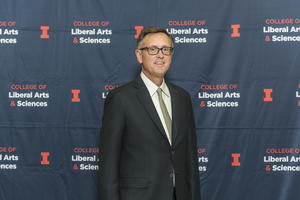Headline: Alumni Richard Clarida, Vice Chair of Fed, Visits Campus
by Michael Semaca, Economics Alumni Intern
Department of Economics alumni Richard Clarida returned to the University of Illinois at Urbana-Champaign on Friday to accept the LAS Alumni Achievement Award. Dr. Clarida received the award due to his considerable academic and public service record spanning four decades. He is the first alumni of the Department of Economics to receive the award.
Clarida currently serves as the Vice Chairman of the Federal Reserve in Washington, DC, making him the second highest authority over the nation’s economic policy. He was nominated to the position by President Donald J. Trump in April 2018, and was confirmed by the Senate in August with bipartisan approval.
Dr. Clarida graduated from Illinois in 1979 with a degree in economics. He then earned both his Master’s and Doctorate degrees at Harvard University in 1983. In 1988, he accepted a position at Columbia University, where he currently serves as the C. Lowell Harriss Professor of Economics. Clarida is currently on leave from Columbia while he works at the Federal Reserve.
While on campus, Clarida presented a seminar to students and faculty entitled “The Effect of Global Factors on the Neutral Policy Interest Rate.” The lecture focused on how central banks like the Federal Reserve target certain inflation rates, and the policies they implement to achieve those rates to keep prices stable.
Most Western countries attempt to keep inflation around two percent, Clarida said. Doing so required performing some form of inflation targeting: a framework for monetary policy aimed at keeping prices stable. Central banks would adjust interest rates to hit a certain inflation target. Clarida said that he and other economists prefer to use the term “inflation forecast targeting” rather than inflation targeting.
“In practice, because of the lags, you’re always implicitly doing some form of inflation forecast targeting; you’re setting policy rates today based upon where inflation is expected to be if you don’t adjust rates,” Clarida explained.
Countries began to implement inflation targeting policies in the 1990s as a way to keep inflation rates low following dramatic increases in the 1970s. Central banks had been able to curb the inflation of the 1970s, but in the process created the worst recession since the Depression, Clarida said. Inflation targeting schemes were meant to decrease the volatility of inflation, and largely achieved that goal.
Many of the implementations were designed to use Professor John Taylor’s “Taylor Rule” as a guide for monetary policymakers to achieve their targeted inflation. As part of his research in the 1990s, Clarida proposed modifying the Taylor Rule into a “Forward Taylor Rule,” setting policies based on where the central bank anticipated inflation and GDP to be at some point in the future.
“We were aware of John’s work, but we were also aware of the fact that it would be very hard to think a simple rule like this could actually be consistent with the correlations we see in the data,” Clarida said.
In 2010, Clarida used his Forward Taylor Rule to analyze how Fed policy may have influenced the Great Recession. He compared the interest rate that his rule suggested and the rate the Fed actually used, and found that his model recommended using higher interest rates from 2003 to 2005 than were actually used. Clarida suggested that the Fed’s inability to raise interest rates during that time contributed to the financial bubble that led to the Recession.
Once the Recession hit, central banks around the world cut interest rates in a “textbook” manner, Clarida said, until rates neared zero. With the crisis still in full swing, banks turned to quantitative easing, a form of monetary policy where the central bank buys a large amount of government bonds. Economists predicted that such a move would increase inflation, but that did not happen, Clarida said.
“When central banks buy government bonds, they create reserves in the banking system that are excess of those required, relative to the deposit base,” Clarida explained. “The great inflation did not happen in the last decade because the banking system did not create credit with the deposit expansion as they did before the crisis.”
Download or full size photos at: ![]()
More about Richard Clarida and his visit to Illinois here
